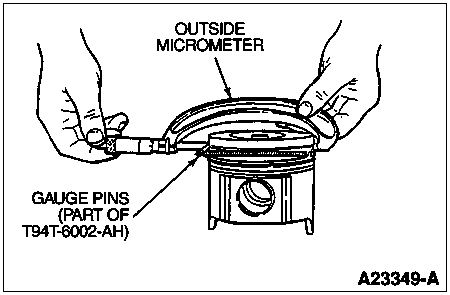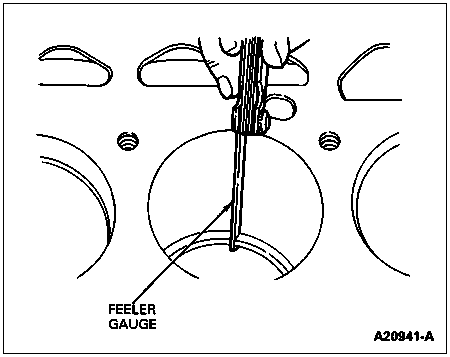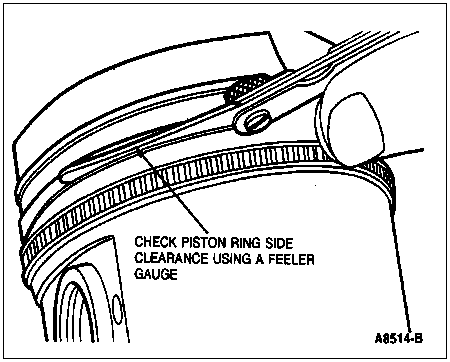Section 03-01D: Engine, Diesel, 7.3L | 1996 F-Series Workshop Manual |
Cleaning
![]() CAUTION: Do not use a caustic cleaning solution or a wire brush to clean pistons.
CAUTION: Do not use a caustic cleaning solution or a wire brush to clean pistons.
![]() CAUTION: Extreme care must be used when cleaning grooves on aluminum pistons.
CAUTION: Extreme care must be used when cleaning grooves on aluminum pistons.
Remove deposits from the piston surfaces. Clean gum or varnish from the piston skirt, piston pins (6135) and piston rings with solvent.
Clean the ring grooves by breaking the old compression ring and using the good edge to clean out any varnish or deposits. Use the top compression ring to clean the top ring groove and the second compression ring to clean the second ring groove because they are different ring designs.
Inspection
| Description | Tool Number |
|---|---|
| Keystone Piston Ring Gauge Set | T94T-6002-AH |
Carefully inspect the piston for fractures at the ring lands, skirts, oil ring slot corners and pin bosses, and for scuffed, rough or scored skirts. If the lower inner portion of the ring grooves has a high step, replace the piston.
Check keystone piston ring groove wear using Keystone Piston Ring Gauge Set T94T-6002-AH. Install the gauge pins in the appropriate groove and measure diameter with an outside micrometer. The acceptable range for the top compression ring groove is 4.097-4.130 inches. If specification is not in the acceptable range, replace the piston.

Check intermediate and oil control ring side clearance using a feeler gauge in between the ring and the ring land. Refer to Specifications for proper clearances.
A shiny surface on the thrust surface of the piston, offset from the centerline between the piston pin holes, can be caused by a bent connecting rod (6200). Replace pistons that show signs of excessive wear, wavy ring lands, fractures or damage.
Check the piston-to-cylinder bore clearance by measuring the piston and bore diameters. Refer to Specifications for the proper clearance. Refer to Cylinder Block in the Cleaning and Inspection portion of this section for the bore measurements procedure. Measure the outside diameter of the piston and check piston-to-bore clearance.
Replace piston pins showing signs of fracture, etching or wear. Check the piston pin fit in the piston and connecting rod.
Check the outside diameter of the piston pin and the inside diameter of the pin bore in the piston. Replace any piston pin or piston that is not within specifications. Refer to Specifications in this section.
Pistons, Fitting
Pistons are available for service in standard size and oversize. Measure the cylinder bore with a cylinder bore micrometer for size, taper and out-of-round. Measure the piston diameter with an outside micrometer. Determine if piston-to-bore clearance, taper and out-of-round are within specifications. If not within specifications, the cylinder will have to be bored oversize and rehoned, and oversized pistons will have to be installed. Refer to Cylinder Block in the Cleaning and Inspection portion of this section.
Piston Pins, Fitting
Measure piston pin bore inside diameter.
Measure piston pin outside diameter.
Subtract piston pin outside diameter from pin bore inside diameter to determine clearance.
Check to see if clearance is acceptable. Refer to Specifications at the end of this section. If clearance is not within specifications, replace component that is not within specification.
Piston Rings, Fitting
Position piston ring in cylinder bore in which it is going to be used.
Push piston ring down into bore area where normal ring wear is not encountered.
![]() CAUTION: Use caution to avoid damage to piston ring or cylinder bore.
CAUTION: Use caution to avoid damage to piston ring or cylinder bore.
Position piston ring in bore so piston ring is square with cylinder wall.
Measure gap between ends of piston ring with a feeler gauge. If piston ring end gap is greater than specified limits, try another partial piston ring set (6148). If piston ring end gap is less than specified limits, carefully file piston ring ends to achieve correct piston ring end gap. Refer to Specifications in this section.

NOTE: Always use a piston ring expanding tool to install rings on a piston.
Install piston rings.
Check ring side clearance of second compression ring with a feeler gauge inserted between piston ring and its lower land. Gauge should slide freely around entire ring circumference without binding. Any wear that occurs will form a step at inner portion of lower land. If lower lands have high steps, piston should be replaced.
Piston rings should be staggered on the piston to make sure the piston ring end gaps are not aligned.
